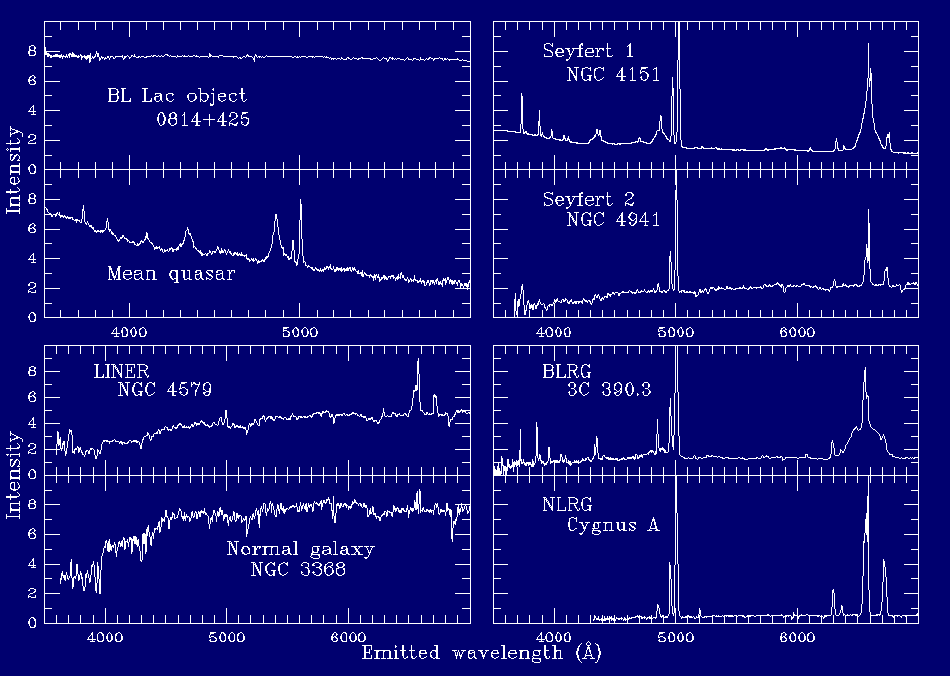
Many of the distinctions among the various flavors of AGN rely on spectroscopic clues, shown here in a montage of optical spectra of some examples. They have all been shifted to their emitted wavelength scales for ease of comparison. Seyfert and radio galaxies come in flavors with all emission lines about the same width (Seyfert 2, narrow-line radio galaxy or NLRG) and with certain emission lines much broader (Seyfert 1, broad-line radio galaxy or BLRG). These pairs are similar in optical spectrum, except that BLRGs may have emission lines that are broader and contain more profile structure than found in Seyfert 1 nuclei. Quasars, represented here by a composite produced from many individual objects, have a family resemblance to Seyfert 1 nuclei, and in most cases, the bumps of Fe II emission are even more prominent in quasars, rippling the spectrum between the strong individual lines. BL Lacertae objects have virtually featureless spectra, making even their redshifts difficult to measure unless the surrounding galaxy can be detected, or emission lines show up when the nucleus is temporarily much fainter than usual. At lower activity levels, many galaxies contain nuclear emission regions known as LINERs (Low-Ionization Nuclear Emission-Line Regions), which are in at least some cases a lower-luminosity version of the processes seen in more traditional active nuclei. For example, NGC 4579, shown here, has a very faint Seyfert 1-like broad component to its H-alpha emission, and a modestly bright ultraviolet central source. Finally, a normal galaxy spectrum (of an early-type spiral, NGC 3368) is shown for comparison. Most of its spectrum shows the combined absorption features from the atmospheres of individual stars, with weak emission lines from gas in star-forming regions ionized by hot young stars.
The QSO and BL Lacertae object spectra have good data only in the bluer range, so that they are plotted only from 3500-6000 Angstroms, rather than 3500-7000 as for the other kinds of object. The NGC 4151 spectrum is from the composite data set depicted in full on slide 5. NGC 4579 and NGC 4941 are from observations at Mt. Lemmon Observatory described by Keel in ApJ 269, 466 (1983). Cygnus A was observed with the 4-meter telescope of Kitt Peak National Observatory, as published by Owen, O'Dea, and Keel in ApJ 352, 44 (1990). Charles Lawrence provided his spectra, obtained with the 5-m Hale telescope at Palomar, for 0814+425 and 3C 390.3 (described by Lawrence et al. in ApJ Suppl 107, 541, 1996). The "mean quasar" spectrum is from a composite generated by Paul Francis and colleagues (see Francis et al. ApJ 373, 465, 1991). The normal-galaxy spectrum of NGC 3368 is from the spectroscopic atlas of galaxies produced by Rob Kennicutt (ApJ Suppl ) with data available through the Astronomical Data Center at NASA Goddard.